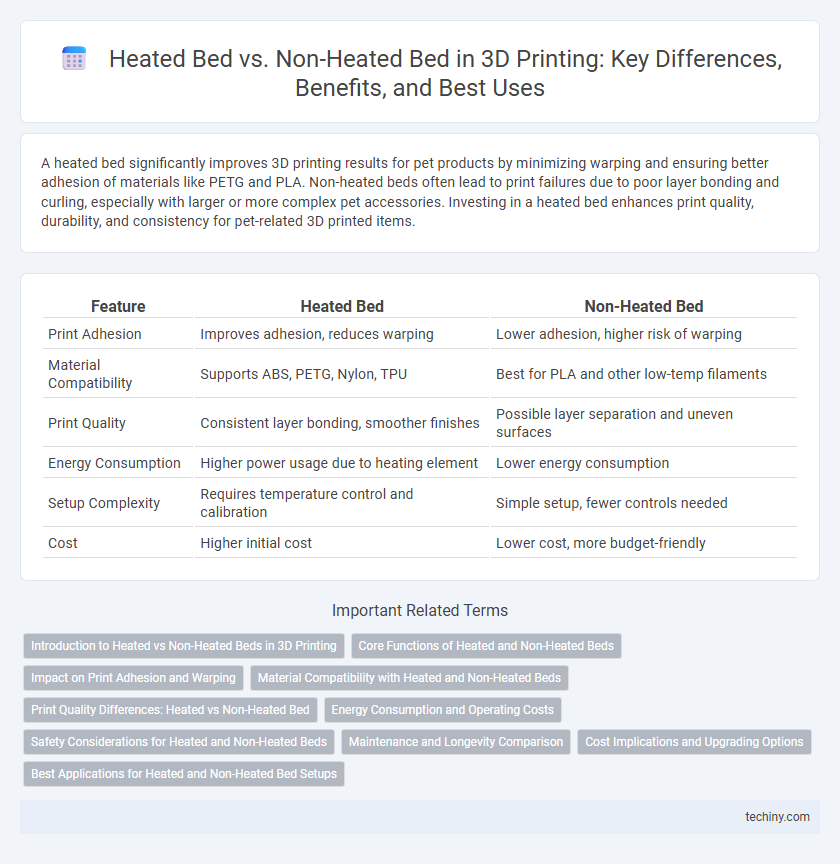A heated bed significantly improves 3D printing results for pet products by minimizing warping and ensuring better adhesion of materials like PETG and PLA. Non-heated beds often lead to print failures due to poor layer bonding and curling, especially with larger or more complex pet accessories. Investing in a heated bed enhances print quality, durability, and consistency for pet-related 3D printed items.
Table of Comparison
| Feature | Heated Bed | Non-Heated Bed |
|---|---|---|
| Print Adhesion | Improves adhesion, reduces warping | Lower adhesion, higher risk of warping |
| Material Compatibility | Supports ABS, PETG, Nylon, TPU | Best for PLA and other low-temp filaments |
| Print Quality | Consistent layer bonding, smoother finishes | Possible layer separation and uneven surfaces |
| Energy Consumption | Higher power usage due to heating element | Lower energy consumption |
| Setup Complexity | Requires temperature control and calibration | Simple setup, fewer controls needed |
| Cost | Higher initial cost | Lower cost, more budget-friendly |
Introduction to Heated vs Non-Heated Beds in 3D Printing
Heated beds in 3D printing provide a controlled surface temperature that improves adhesion, reduces warping, and enhances print quality, especially for materials like ABS and PETG. Non-heated beds are simpler and cost-effective but may cause issues with print adhesion and increased warping, limiting their effectiveness to PLA and other low-warp materials. Choosing between heated and non-heated beds depends on the filament type, print size, and desired print reliability.
Core Functions of Heated and Non-Heated Beds
Heated beds in 3D printing stabilize the printing surface temperature, improving adhesion and reducing warping of materials like ABS and PETG during printing. Non-heated beds rely on room temperature and adhesive aids such as glue sticks or painter's tape, suitable mainly for PLA and other low-warping filaments. The core function of heated beds is to maintain consistent heat to enhance print quality, while non-heated beds provide a basic platform with less control over material behavior.
Impact on Print Adhesion and Warping
A heated bed significantly improves print adhesion by maintaining a consistent temperature that prevents the base layer from cooling too quickly, which reduces the risk of warping. Non-heated beds often lead to poor adhesion and increased warping, especially with materials like ABS or PETG that require higher temperatures for optimal bonding. Using a heated bed enhances layer stability and overall print quality, making it essential for complex or large 3D prints.
Material Compatibility with Heated and Non-Heated Beds
Heated beds enhance adhesion and reduce warping for materials like ABS, PETG, and Nylon, which require consistent surface temperatures during printing. Non-heated beds are generally compatible with PLA and TPU, which have lower print temperature requirements and adhere well to cooler surfaces. Choosing the correct bed type ensures optimal print quality and material performance across diverse filament types.
Print Quality Differences: Heated vs Non-Heated Bed
Heated beds significantly improve print quality by enhancing adhesion and reducing warping, especially with materials like ABS and PETG that require consistent temperatures to prevent layer separation. Non-heated beds often result in poor first-layer adhesion and increased risk of warping or curling, limiting material choices and affecting dimensional accuracy. Maintaining a heated bed temperature between 50degC and 110degC optimizes layer bonding and surface smoothness, leading to more precise and durable 3D prints.
Energy Consumption and Operating Costs
Heated beds consume more energy than non-heated beds due to their constant power draw to maintain optimal printing temperatures, impacting overall operating costs. Non-heated beds offer reduced energy consumption and lower electricity expenses but may compromise print adhesion and quality, especially with ABS or other temperature-sensitive materials. Choosing between heated and non-heated beds requires balancing energy efficiency against material compatibility and print reliability.
Safety Considerations for Heated and Non-Heated Beds
Heated beds in 3D printing improve adhesion and reduce warping but require careful temperature management to prevent burns and electrical hazards. Non-heated beds reduce the risk of overheating and are safer for beginners but may lead to print adhesion issues, increasing failed prints and potential filament jams. Proper insulation and thermal cutoffs are essential safety measures to minimize risks associated with heated beds.
Maintenance and Longevity Comparison
Heated beds in 3D printing reduce warping by maintaining consistent print temperatures, which minimizes material stress and prolongs print quality over time. Non-heated beds require frequent surface cleaning and repositioning to prevent print adhesion issues, often leading to quicker wear and more frequent maintenance. Overall, heated beds offer enhanced durability and lower upkeep, extending the printer's lifespan and improving long-term reliability.
Cost Implications and Upgrading Options
Heated beds increase the initial cost of 3D printers but enhance print quality by reducing warping, especially with ABS and other high-temperature filaments, ultimately saving money on failed prints. Non-heated beds are more affordable but limit material options and often require additional adhesion aids, potentially raising operating expenses over time. Upgrading to a heated bed is a cost-effective improvement for budget printers, as it extends filament compatibility and improves print reliability without purchasing a new machine.
Best Applications for Heated and Non-Heated Bed Setups
Heated beds are ideal for printing with materials prone to warping such as ABS, PETG, and Nylon, ensuring better adhesion and reduced print failures. Non-heated beds suit PLA and other low-temperature filaments, offering a cost-effective and simpler setup for beginners and hobbyists. Selecting the appropriate bed type enhances print quality by matching material properties and thermal requirements.
Heated Bed vs Non-Heated Bed Infographic

 techiny.com
techiny.com